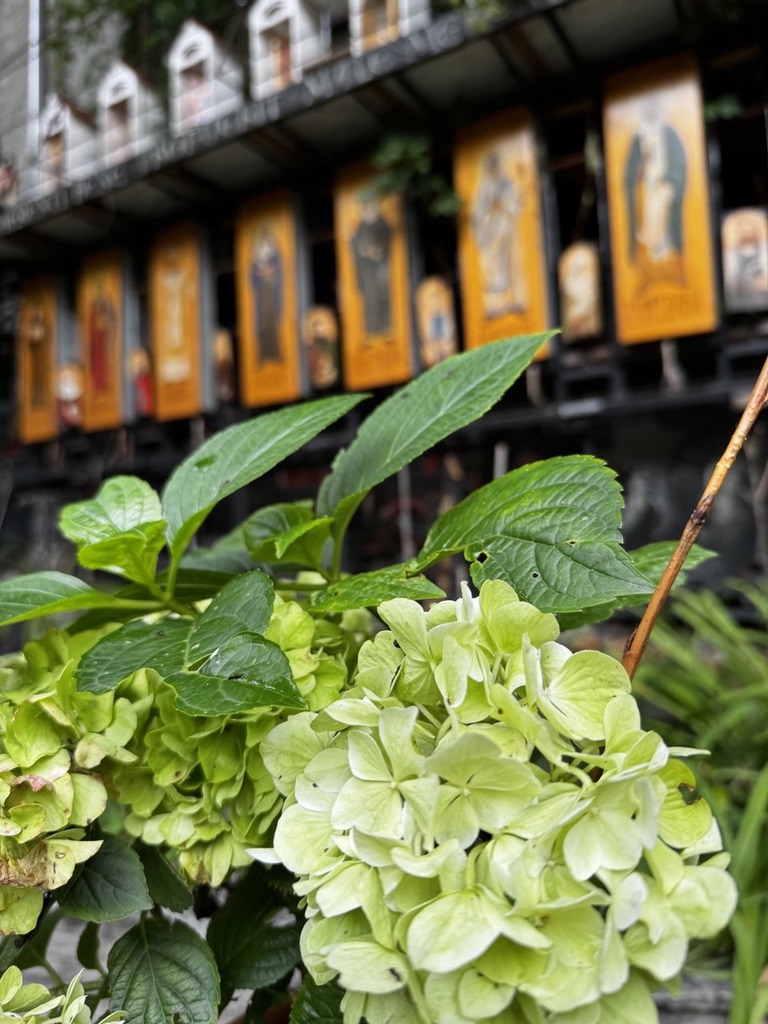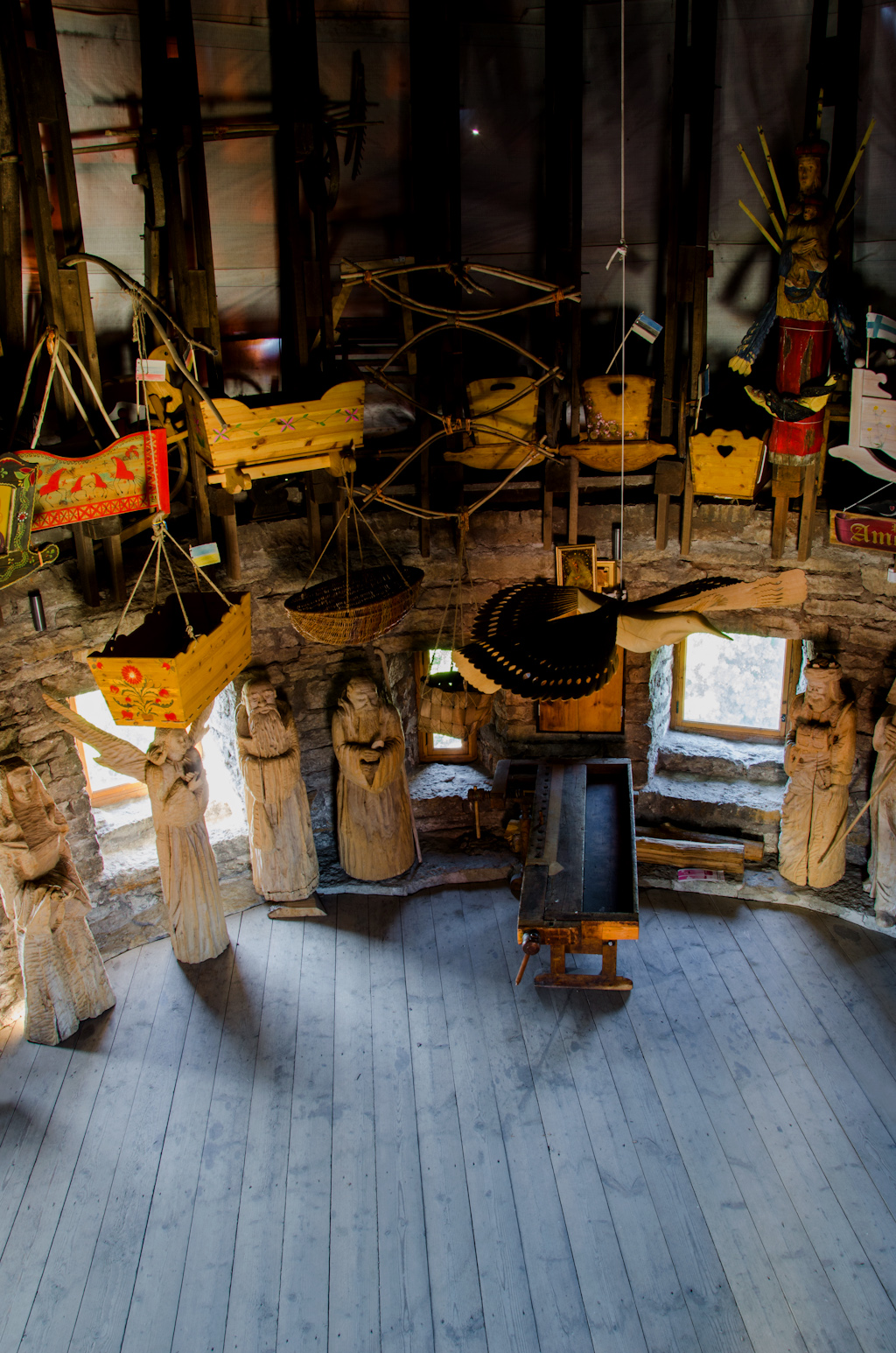The Ukrainian Cultural Center continues the tradition of medieval educational museums and does its best to preserve endangered crafts and arts. To this end, an ethnographic educational museum was created, consisting of a diverse collection of Ukrainian folk costumes, toys, and other artifacts. Many of the items are gifts from Ukrainians living in different corners of the world – Estonia, Ukraine, the USA, and Asia.
We gratefully accept new artifacts to add to our collections. Currently, our collections include Ukrainian embroidered shirts (vyshyvanka) and towels (rushnyk), painted eggs (pysanka), and wooden and textile toys. We have also collected a smaller number of traditional Ukrainian jewelry, clay dishes, Ukrainian banknotes, and more.
Our special collections include Nina Vynnyk’s tapestries and embroidery books and Olena Zaporozhets’is watercolors. The Ukrainian Cultural Center occasionally organizes exhibitions to introduce our collections to a wider audience.
We would be happy to organize an exhibition with you, in your city, cultural center, or museum. Please write to us at ukk.tallinn@gmail.com.

St. Hildegard’s Courtyard
We do not know for certain whether Saint Hildegard ever visited our city, which would later be given the Latin name Revalia, but we believe that she would have liked our medieval courtyard, which is dedicated to her. For us who work at the Ukrainian Cultural Center, Hildegard’s courtyard is a wonderful oasis in the middle of our sanctuary, where birds sing and goldfish swim in a small pond. It is Hildegard’s courtyard that creates the first impression for our guests. And the first thing they notice is one of Anatoly Ljutjuk’s latest projects – the Mechanical Toy Theater Moralite.
When the weather is nice, don’t rush and take a look around. There is much to see here: Hildegard’s courtyard, which is maintained by the local Hildegard Society; our vegetable garden on the roof, the harvest of which we eat together at lunch; Jesus with a stone and rose hips; the cheerful dog Muška and the cautious cat Runa. In summer, the days are longer and our courtyard becomes so peaceful that various birds, insects, and small animals come here to find quiet and rest among the stone walls, in the shade of our tall trees, whose tops reach for the clouds.
The most attentive observers will also find traces of Hildegard’s hand.
In the courtyard, we also tell our guests about Hildegard’s life and wisdom, medicinal herbs, and animals that also live in the old town; we talk about medieval gardens, including what grows on our roof; and we show our Morality Theater.
We look forward to welcoming you!
Photo – Nataliia Chebotarova

Our Labora Workshops
Located within the Ukrainian Cultural Center at number 22 Laboratooriumi Street, you will find our Labora Worskhops which include a variety of different studios for paper making, calligraphy, letterpress printing, and more. In these workshops, Labora’s Masters use their hands to create beautiful books – each one with its own unique story to tell. Labora also makes postcards, greeting cards, and a variety of other paper products to inspire people around the world to keep in touch and connect in thoughtful, personal, and meaningful ways. By combining illustrations with calligraphy and typography, Labora hopes to add some beauty to the world.
Learn more about Labora on their website.
Watch Art-Life’s six-minute video about Labora’s Masters at work. (In Estonian with English-language subtitles.)

Our Tower
Our tower, known as Grusbeke Tower, supports and houses several different art worlds and is located at Laboratoorium 33. The first floor houses a chapel dedicated to the Virgin Mary, the protector of Estonia. Here, daily prayers are said for Estonian nature.
The second floor has become home to our wooden folk toys and collection of wooden horses. And on the top floor, the third, you will find wooden replicas of medieval weapons, or Our Weapons Museum, as we call it.
And under the ceiling flutters our wooden wonder bird.
Our Collections

Our Collection of Wooden Toy Horses
No one quite remembers how the first wooden horse found its way to the Ukrainian Cultural Center. Perhaps Anatoli himself made it from various branches of wood. In any case, a second horse and then a third one soon followed. After that, our friends got it into their heads that the Center was working on something new and so people from all over this part of the world started bringing us horses until we had a large wooden herd. And then there was that crazy itinerant wooden horse collector who gave our Center his entire collection – or at least most of it.
What then should we do with all these wooden horses? Yes, the wooden horses turned out be just the thing that our Center needed when we were running our integration projects – especially those built around the making of wooden toys. And yet, most of the wooden horses still sat around in boxes or gathered dust on shelves. Everything changed one day when a Wooden Horse Whisperer visited the Center and decided to tame this wild herd and bring some order to this wooden chaos. You can see her impressive results here at The Wooden Horse: A Virtual Museum.

Our Library
The Ukrainian Cultural Center has one of the largest private Ukrainian libraries in Estonia. It consists mainly of classic and contemporary Ukrainian literature, but there are also books on Ukrainian ethnography, history, and art.
Most of the books were donated to the Center by local Ukrainians. The collection also includes the personal collection of Ukrainian literature belonging to translator and poet Harald Rajamets, which was brought to us by Rajamets’s nephew after the translator passed away. Harald Rajamets introduced Ukrainian literature to Estonian readers, started the tradition of translating only from Ukrainian, and compiled the first Ukrainian-Estonian alphabet chart. Thanks to him, Estonian readers are familiar with Ukrainian authors such as Dmytro Pavlychko, Lina Kostenko, and Mykola Vingranovsky, not to mention such classics as Lesya Ukrainka and Taras Shevchenko.
Other treasures in our library include an extensive collection of Kobzars – 22 different volumes; the complete works of Lesya Ukrainka, Ivan Franko, Mykhailo Kotsyubynsky, and others; and larger and smaller handmade books that were created in our scriptorium.

Our Toy and Historical Weapons Museum
In order to preserve endangered handicraft skills and arts, the Ukrainian Cultural Center created a museum consisting of a diverse collection of Ukrainian folk costumes, wooden toys, and other artifacts.
Our museum also has beautiful Ukrainian embroidered shirts, scarves, painted eggs – pysanky – and wooden folk toys.
Few people know that our tower in Grusbeke also houses a museum of toys from around the world, which also has several cool replicas of historical weapons. Or the “Weapons Museum,” as we call it. It is located on the third floor, and its most frequent visitors are children, who are fascinated by how people used to fight in the old days. We invite you to visit our virtual museum of toy replicas of historical weapons!
The second floor houses a colorful collection of toys – our Toy Museum, which we are happy to show to our guests, encouraging them to make toys for their children with their own hands. In addition to the herd of wooden horses standing right at the entrance, you can also find Ukrainian folk toys, a puppet theater, and many animal figurines. We look forward to seeing you at the Ukrainian Cultural Center in the Old Town of Tallinn or at our virtual toy museum.

Our Smithy
Our smithy is located at Laboratooriumi 25. It is a small house that blends in with the old town’s defensive wall and houses a large collection of woodworking tools, an authentic Ukrainian stove, and some parts of the Mechanical Morality Theater, such as Jesus with millstones and St. Peter the fisherman.
